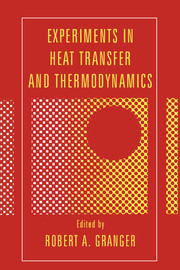Book contents
- Frontmatter
- Contents
- Preface
- Introduction
- Part I Experiments in heat transfer
- I.1 Conduction
- I.2 Convection
- I.3 Boiling
- Experiment 17 Capillary-tube boiling
- Experiment 18 Two characteristic regions of nucleate pool boiling and corresponding change of hydrodynamic state
- Experiment 19 The boiling slide
- Experiment 20 Evaporation and boiling in sessile drops on a heated surface
- I.4 Mixing, dispersion, and diffusion
- I.5 Radiation
- I.6 Heat pipes and exchangers
- Part II Experiments in thermodynamics
- Appendix 1 Experiments and demonstrations in thermodynamics
- Appendix 2 Experiments and demonstrations in heat transfer
- Appendix 3 Heat-transfer and thermodynamic films
- Index
Experiment 19 - The boiling slide
Published online by Cambridge University Press: 05 June 2012
- Frontmatter
- Contents
- Preface
- Introduction
- Part I Experiments in heat transfer
- I.1 Conduction
- I.2 Convection
- I.3 Boiling
- Experiment 17 Capillary-tube boiling
- Experiment 18 Two characteristic regions of nucleate pool boiling and corresponding change of hydrodynamic state
- Experiment 19 The boiling slide
- Experiment 20 Evaporation and boiling in sessile drops on a heated surface
- I.4 Mixing, dispersion, and diffusion
- I.5 Radiation
- I.6 Heat pipes and exchangers
- Part II Experiments in thermodynamics
- Appendix 1 Experiments and demonstrations in thermodynamics
- Appendix 2 Experiments and demonstrations in heat transfer
- Appendix 3 Heat-transfer and thermodynamic films
- Index
Summary
Principle
An image of an electrically heated wire boiling under water is projected on a screen. Boiling in real time is easily observed.
Object
This experiment provides a greatly enlarged, easily controlled demonstration of boiling. The image is so clear the audience leaves with an unforgettable picture of the processes that constitute boiling.
Apparatus
Power is brought into the projector through the posts that are fastened to the lid of the slide. (The lid is shown in profile in Fig. 19.1.) The posts are fastened to leads that are made of springy copper strips with clips on the ends which hold the wire from which the boiling occurs. When the whole device is assembled it looks like Fig. 19.1.
The wire is the only part of the assembly that is critical. We have found that Chromel A wire 0.010 inches in diameter is appropriate. This wire passes through critical heat flux (CHF, burnout, boiling transition, etc.) when an AC current of 6.4 amps passes through it. Very little more current than this also causes the wire to physically burn out.
The power for this wire is provided by a Variac which has a maximum output of 10 amps. An ammeter in the line passing the Variac output is needed to insure that the maximum allowable current is not exceeded.
- Type
- Chapter
- Information
- Experiments in Heat Transfer and Thermodynamics , pp. 142 - 146Publisher: Cambridge University PressPrint publication year: 1994



